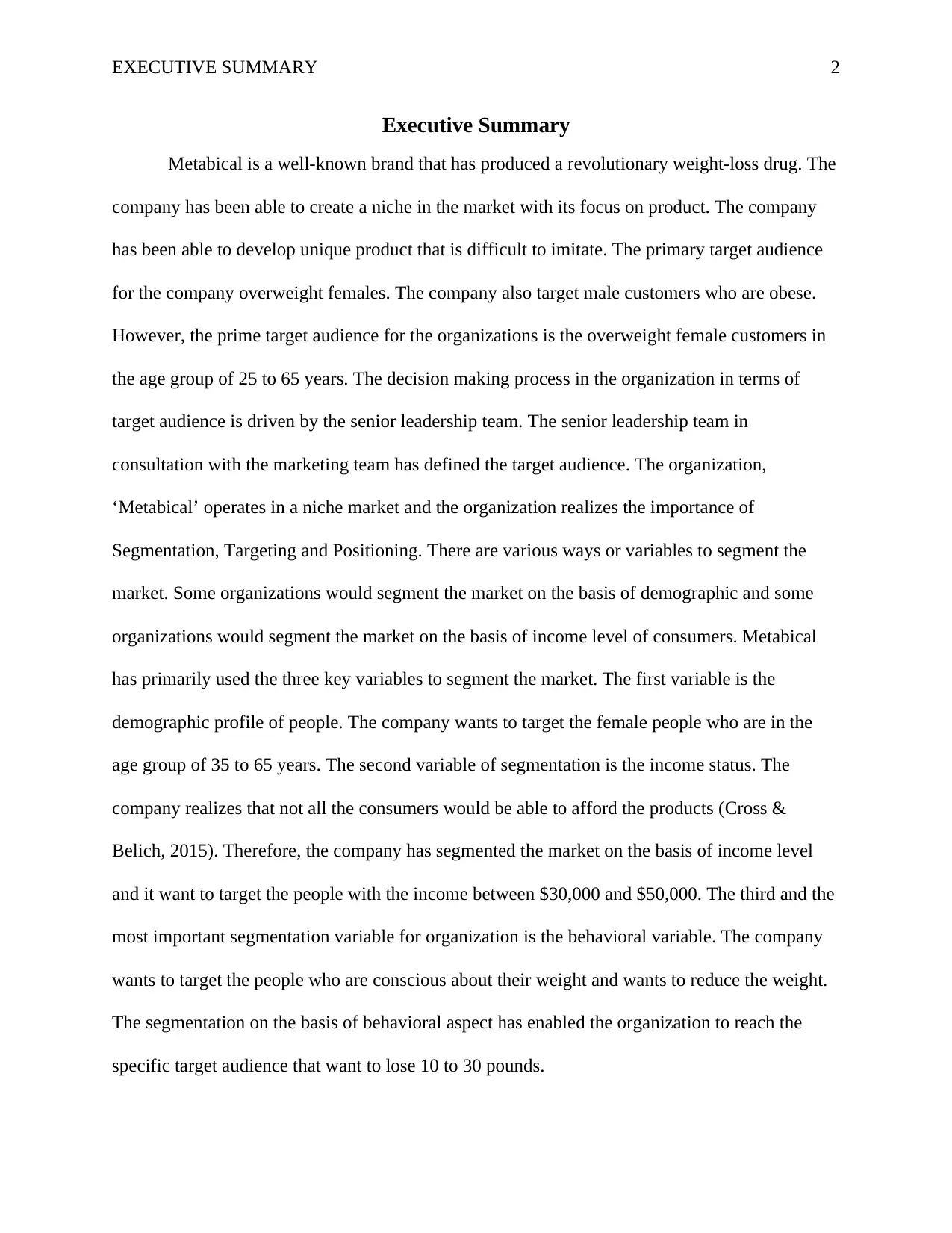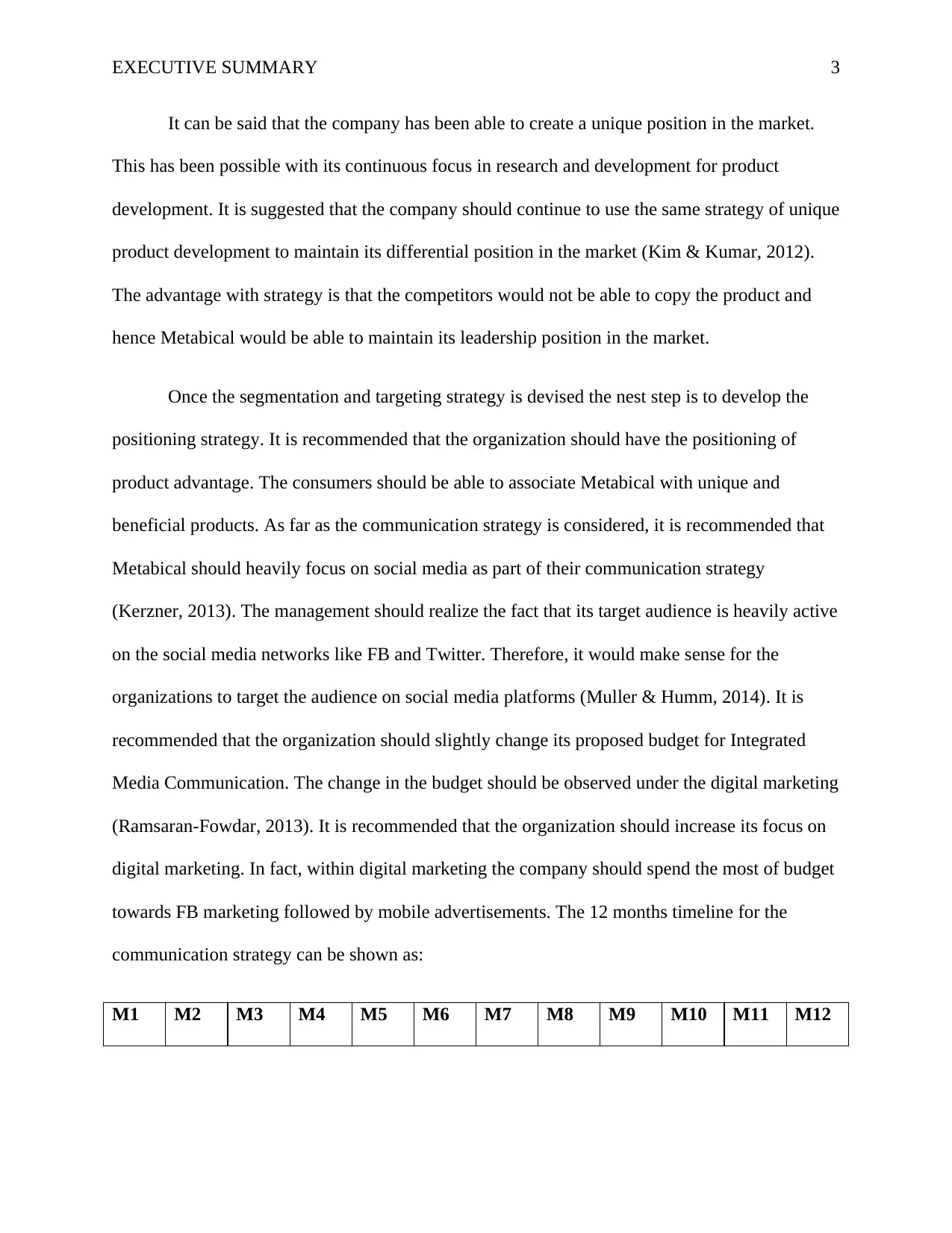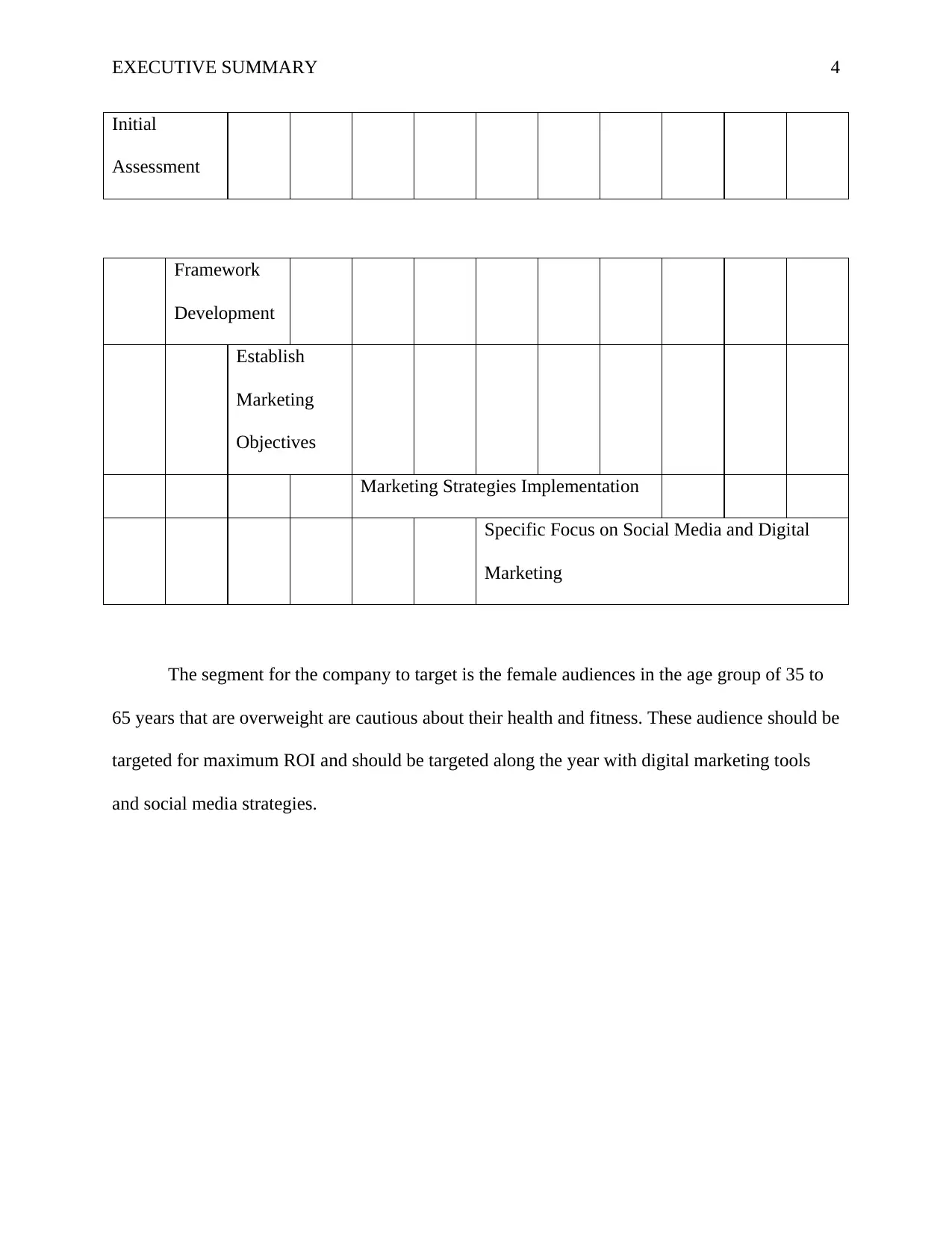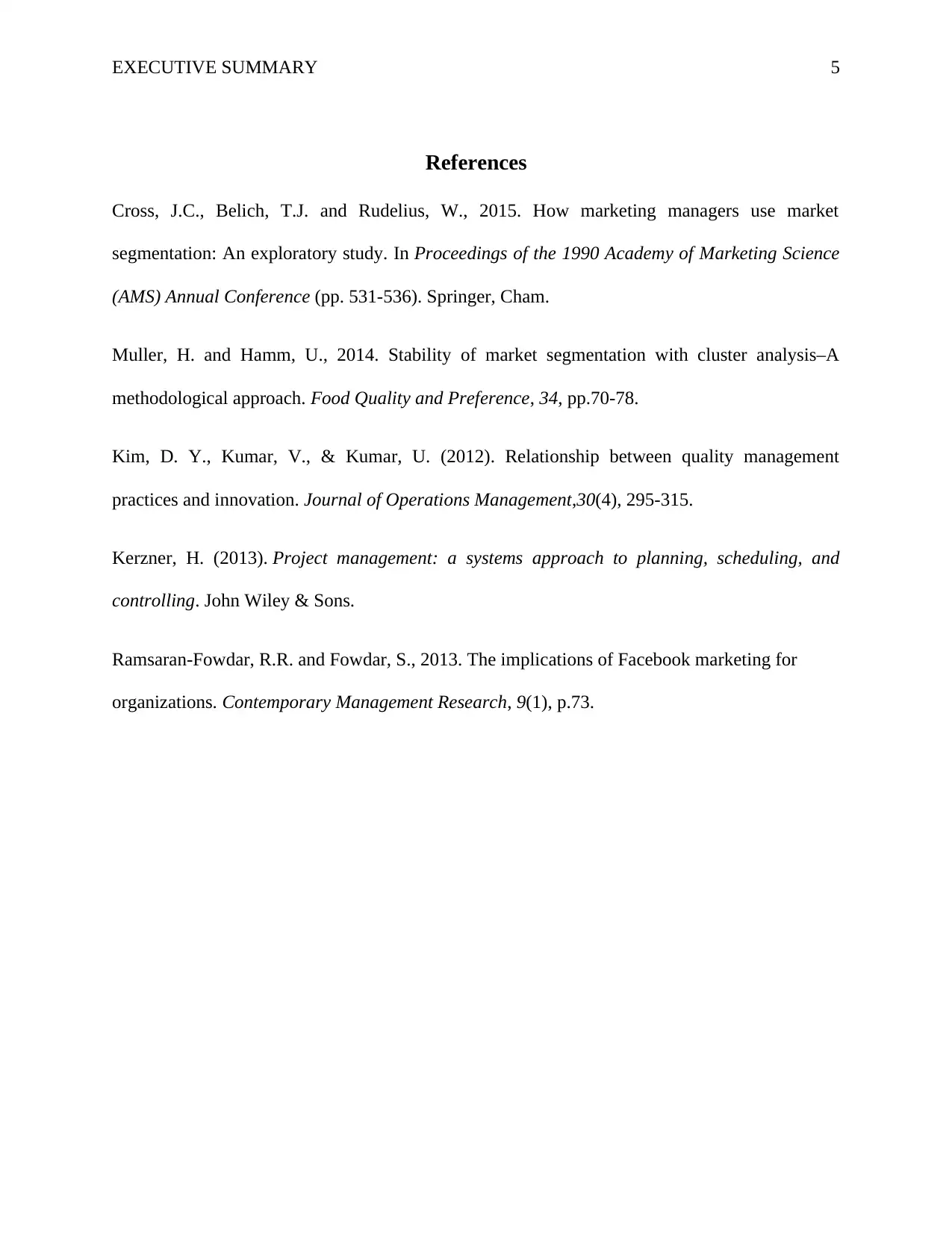Report: Metabical's Market Segmentation, Targeting, and Communication
VerifiedAdded on 2019/10/31
|5
|937
|79
Report
AI Summary
This report provides an executive summary of Metabical's marketing strategy, focusing on its segmentation, targeting, and positioning within the weight-loss market. The company, known for its unique product, targets overweight females aged 25-65 and also considers male customers. The report emphasizes the importance of segmentation using demographic, income, and behavioral variables. Metabical primarily targets women with incomes between $30,000 and $50,000 who are weight-conscious. The report suggests maintaining a focus on product development to sustain a competitive advantage. It recommends a positioning strategy that highlights product benefits and a communication strategy heavily reliant on social and digital media, particularly Facebook and mobile advertisements. The report proposes a 12-month timeline for implementing the communication strategy, emphasizing digital marketing efforts to maximize ROI and target the core audience effectively.

EXECUTIVE SUMMARY
EXECUTIVE SUMMARY
STUDENT NAME
NAME OF THE INSTITUTE
EXECUTIVE SUMMARY
STUDENT NAME
NAME OF THE INSTITUTE
Paraphrase This Document
Need a fresh take? Get an instant paraphrase of this document with our AI Paraphraser

EXECUTIVE SUMMARY
Executive Summary
Metabical is a well-known brand that has produced a revolutionary weight-loss drug. The
company has been able to create a niche in the market with its focus on product. The company
has been able to develop unique product that is difficult to imitate. The primary target audience
for the company overweight females. The company also target male customers who are obese.
However, the prime target audience for the organizations is the overweight female customers in
the age group of 25 to 65 years. The decision making process in the organization in terms of
target audience is driven by the senior leadership team. The senior leadership team in
consultation with the marketing team has defined the target audience. The organization,
‘Metabical’ operates in a niche market and the organization realizes the importance of
Segmentation, Targeting and Positioning. There are various ways or variables to segment the
market. Some organizations would segment the market on the basis of demographic and some
organizations would segment the market on the basis of income level of consumers. Metabical
has primarily used the three key variables to segment the market. The first variable is the
demographic profile of people. The company wants to target the female people who are in the
age group of 35 to 65 years. The second variable of segmentation is the income status. The
company realizes that not all the consumers would be able to afford the products (Cross &
Belich, 2015). Therefore, the company has segmented the market on the basis of income level
and it want to target the people with the income between $30,000 and $50,000. The third and the
most important segmentation variable for organization is the behavioral variable. The company
wants to target the people who are conscious about their weight and wants to reduce the weight.
The segmentation on the basis of behavioral aspect has enabled the organization to reach the
specific target audience that want to lose 10 to 30 pounds.
2
Executive Summary
Metabical is a well-known brand that has produced a revolutionary weight-loss drug. The
company has been able to create a niche in the market with its focus on product. The company
has been able to develop unique product that is difficult to imitate. The primary target audience
for the company overweight females. The company also target male customers who are obese.
However, the prime target audience for the organizations is the overweight female customers in
the age group of 25 to 65 years. The decision making process in the organization in terms of
target audience is driven by the senior leadership team. The senior leadership team in
consultation with the marketing team has defined the target audience. The organization,
‘Metabical’ operates in a niche market and the organization realizes the importance of
Segmentation, Targeting and Positioning. There are various ways or variables to segment the
market. Some organizations would segment the market on the basis of demographic and some
organizations would segment the market on the basis of income level of consumers. Metabical
has primarily used the three key variables to segment the market. The first variable is the
demographic profile of people. The company wants to target the female people who are in the
age group of 35 to 65 years. The second variable of segmentation is the income status. The
company realizes that not all the consumers would be able to afford the products (Cross &
Belich, 2015). Therefore, the company has segmented the market on the basis of income level
and it want to target the people with the income between $30,000 and $50,000. The third and the
most important segmentation variable for organization is the behavioral variable. The company
wants to target the people who are conscious about their weight and wants to reduce the weight.
The segmentation on the basis of behavioral aspect has enabled the organization to reach the
specific target audience that want to lose 10 to 30 pounds.
2

EXECUTIVE SUMMARY
It can be said that the company has been able to create a unique position in the market.
This has been possible with its continuous focus in research and development for product
development. It is suggested that the company should continue to use the same strategy of unique
product development to maintain its differential position in the market (Kim & Kumar, 2012).
The advantage with strategy is that the competitors would not be able to copy the product and
hence Metabical would be able to maintain its leadership position in the market.
Once the segmentation and targeting strategy is devised the nest step is to develop the
positioning strategy. It is recommended that the organization should have the positioning of
product advantage. The consumers should be able to associate Metabical with unique and
beneficial products. As far as the communication strategy is considered, it is recommended that
Metabical should heavily focus on social media as part of their communication strategy
(Kerzner, 2013). The management should realize the fact that its target audience is heavily active
on the social media networks like FB and Twitter. Therefore, it would make sense for the
organizations to target the audience on social media platforms (Muller & Humm, 2014). It is
recommended that the organization should slightly change its proposed budget for Integrated
Media Communication. The change in the budget should be observed under the digital marketing
(Ramsaran-Fowdar, 2013). It is recommended that the organization should increase its focus on
digital marketing. In fact, within digital marketing the company should spend the most of budget
towards FB marketing followed by mobile advertisements. The 12 months timeline for the
communication strategy can be shown as:
M1 M2 M3 M4 M5 M6 M7 M8 M9 M10 M11 M12
3
It can be said that the company has been able to create a unique position in the market.
This has been possible with its continuous focus in research and development for product
development. It is suggested that the company should continue to use the same strategy of unique
product development to maintain its differential position in the market (Kim & Kumar, 2012).
The advantage with strategy is that the competitors would not be able to copy the product and
hence Metabical would be able to maintain its leadership position in the market.
Once the segmentation and targeting strategy is devised the nest step is to develop the
positioning strategy. It is recommended that the organization should have the positioning of
product advantage. The consumers should be able to associate Metabical with unique and
beneficial products. As far as the communication strategy is considered, it is recommended that
Metabical should heavily focus on social media as part of their communication strategy
(Kerzner, 2013). The management should realize the fact that its target audience is heavily active
on the social media networks like FB and Twitter. Therefore, it would make sense for the
organizations to target the audience on social media platforms (Muller & Humm, 2014). It is
recommended that the organization should slightly change its proposed budget for Integrated
Media Communication. The change in the budget should be observed under the digital marketing
(Ramsaran-Fowdar, 2013). It is recommended that the organization should increase its focus on
digital marketing. In fact, within digital marketing the company should spend the most of budget
towards FB marketing followed by mobile advertisements. The 12 months timeline for the
communication strategy can be shown as:
M1 M2 M3 M4 M5 M6 M7 M8 M9 M10 M11 M12
3
⊘ This is a preview!⊘
Do you want full access?
Subscribe today to unlock all pages.

Trusted by 1+ million students worldwide

EXECUTIVE SUMMARY
Initial
Assessment
Framework
Development
Establish
Marketing
Objectives
Marketing Strategies Implementation
Specific Focus on Social Media and Digital
Marketing
The segment for the company to target is the female audiences in the age group of 35 to
65 years that are overweight are cautious about their health and fitness. These audience should be
targeted for maximum ROI and should be targeted along the year with digital marketing tools
and social media strategies.
4
Initial
Assessment
Framework
Development
Establish
Marketing
Objectives
Marketing Strategies Implementation
Specific Focus on Social Media and Digital
Marketing
The segment for the company to target is the female audiences in the age group of 35 to
65 years that are overweight are cautious about their health and fitness. These audience should be
targeted for maximum ROI and should be targeted along the year with digital marketing tools
and social media strategies.
4
Paraphrase This Document
Need a fresh take? Get an instant paraphrase of this document with our AI Paraphraser

EXECUTIVE SUMMARY
References
Cross, J.C., Belich, T.J. and Rudelius, W., 2015. How marketing managers use market
segmentation: An exploratory study. In Proceedings of the 1990 Academy of Marketing Science
(AMS) Annual Conference (pp. 531-536). Springer, Cham.
Muller, H. and Hamm, U., 2014. Stability of market segmentation with cluster analysis–A
methodological approach. Food Quality and Preference, 34, pp.70-78.
Kim, D. Y., Kumar, V., & Kumar, U. (2012). Relationship between quality management
practices and innovation. Journal of Operations Management,30(4), 295-315.
Kerzner, H. (2013). Project management: a systems approach to planning, scheduling, and
controlling. John Wiley & Sons.
Ramsaran-Fowdar, R.R. and Fowdar, S., 2013. The implications of Facebook marketing for
organizations. Contemporary Management Research, 9(1), p.73.
5
References
Cross, J.C., Belich, T.J. and Rudelius, W., 2015. How marketing managers use market
segmentation: An exploratory study. In Proceedings of the 1990 Academy of Marketing Science
(AMS) Annual Conference (pp. 531-536). Springer, Cham.
Muller, H. and Hamm, U., 2014. Stability of market segmentation with cluster analysis–A
methodological approach. Food Quality and Preference, 34, pp.70-78.
Kim, D. Y., Kumar, V., & Kumar, U. (2012). Relationship between quality management
practices and innovation. Journal of Operations Management,30(4), 295-315.
Kerzner, H. (2013). Project management: a systems approach to planning, scheduling, and
controlling. John Wiley & Sons.
Ramsaran-Fowdar, R.R. and Fowdar, S., 2013. The implications of Facebook marketing for
organizations. Contemporary Management Research, 9(1), p.73.
5
1 out of 5
Related Documents
Your All-in-One AI-Powered Toolkit for Academic Success.
+13062052269
info@desklib.com
Available 24*7 on WhatsApp / Email
![[object Object]](/_next/static/media/star-bottom.7253800d.svg)
Unlock your academic potential
Copyright © 2020–2025 A2Z Services. All Rights Reserved. Developed and managed by ZUCOL.





